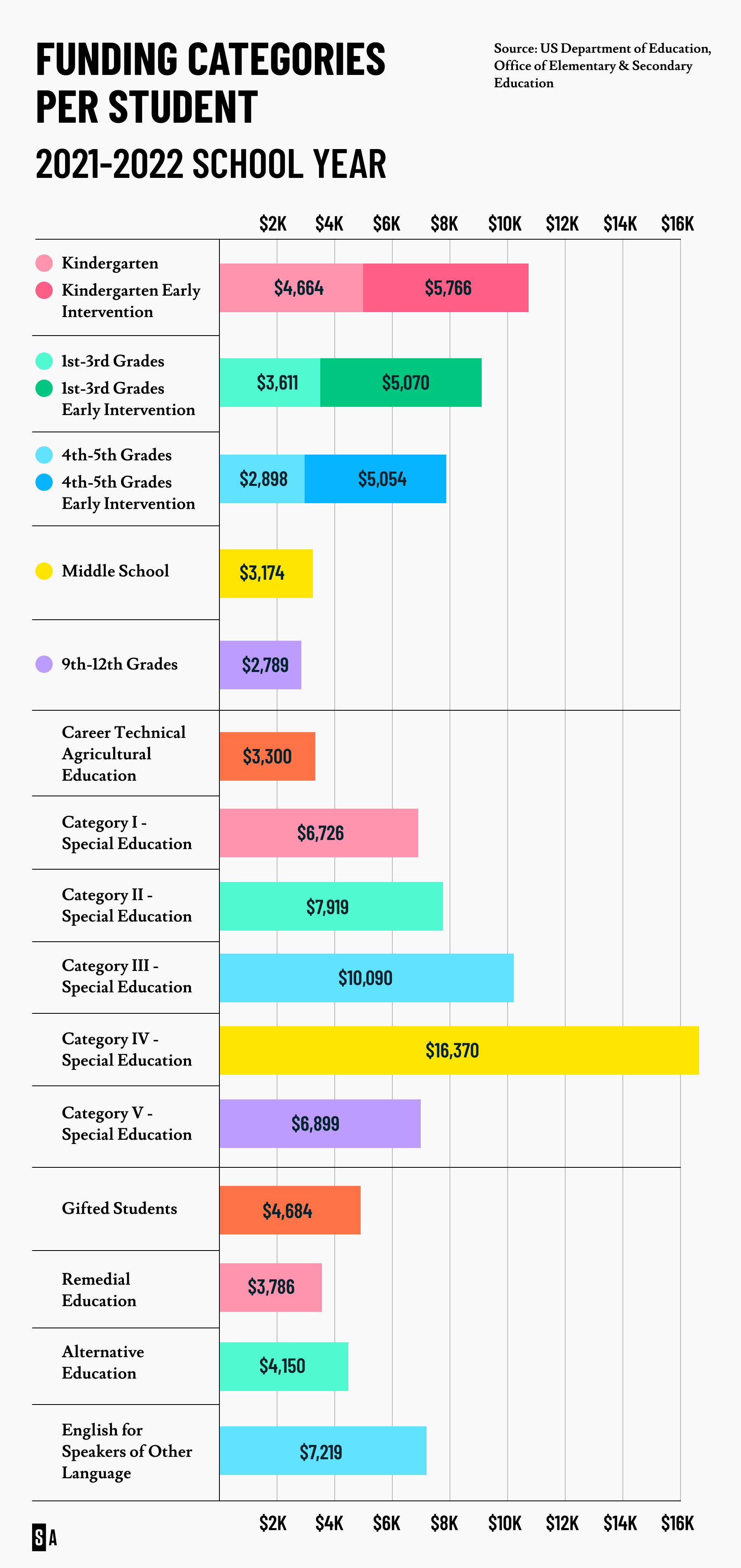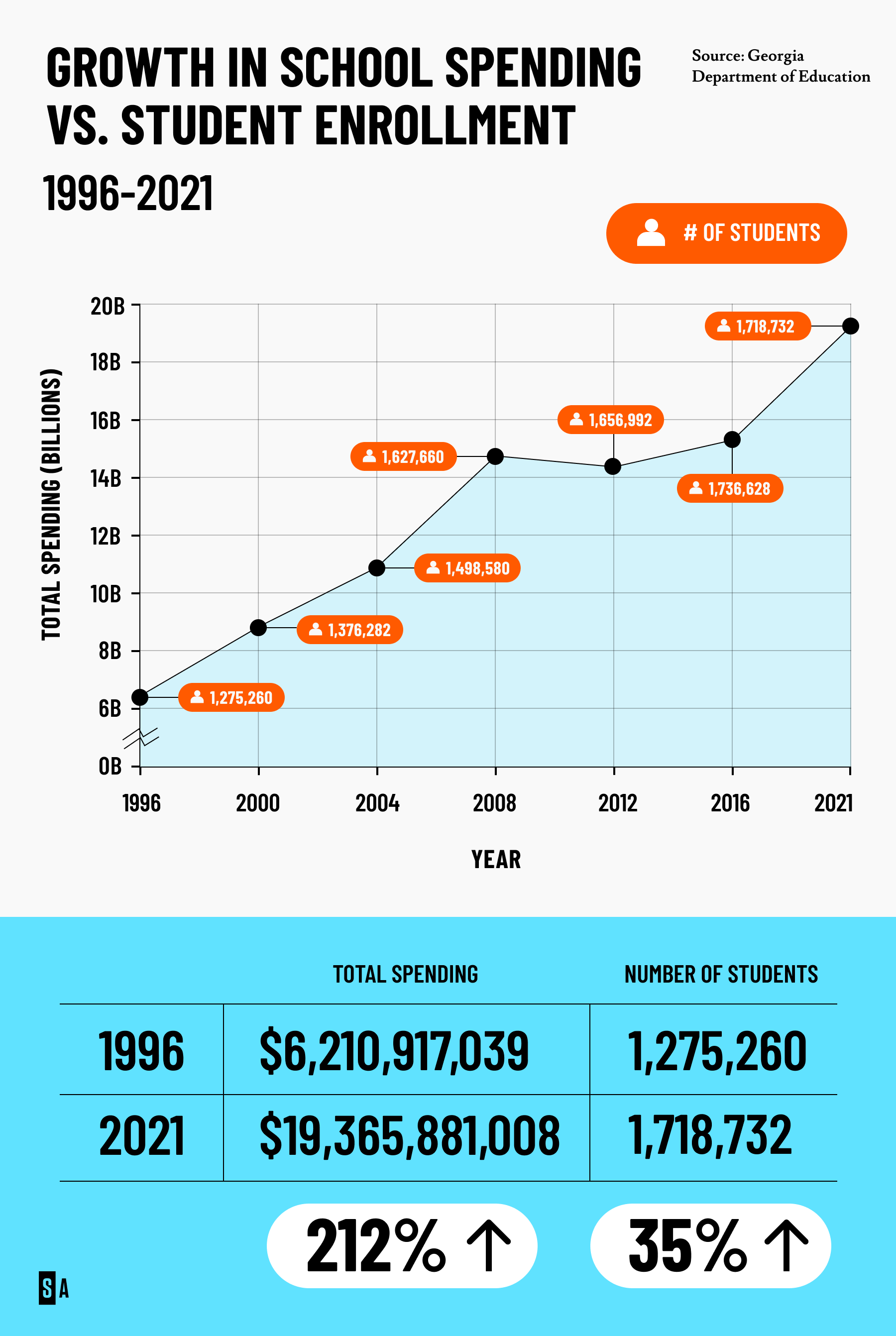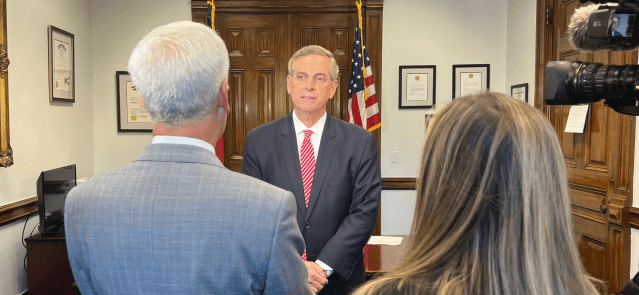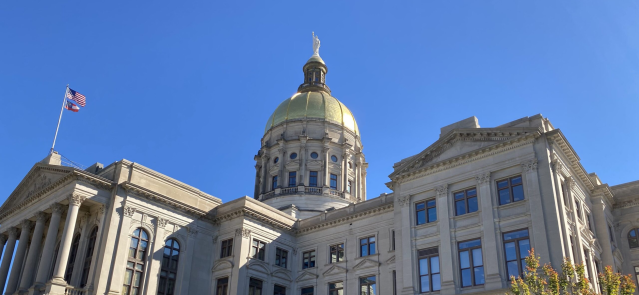Stay ahead of the curve as a political insider with deep policy analysis, daily briefings and policy-shaping tools.
Request a DemoDo Georgia’s low-income students need more state school funding?

Illustration by Brittney Phan (State Affairs)
- More than half a million Georgia students live in poverty or other underprivileged situations.
- Georgia is one of only six states that do not factor low-income students in its school-funding model.
- Many state lawmakers and experts agree Georgia’s funding model needs an update – but no progress has been made.
Taxpayers spend billions of dollars each year on Georgia’s public k-12 schools, but none of the state’s education dollars goes specifically to kids from low-income families who often struggle in class, State Affairs has found.
Georgia is one of only six states that do not factor low-income students into their annual school-funding formulas – even as roughly one-third of Georgia’s roughly 1.7 million students in county and city public schools were classified by the state as living in poverty last year.
The omission has prompted some state lawmakers and policy experts to call for overhauling Georgia’s complex funding formula for schools. Others doubt the General Assembly has enough political will to change the nearly 40-year-old system that decides how to spread more than $12 billion among 2,300 local schools.
“We haven’t had someone take a hard look at what kids need, at least since I’ve been following it,” said Stephen Owens, a senior policy analyst with the nonprofit Georgia Budget and Policy Institute (GBPI) who focuses on education issues. “I think it comes from a fear that we will be shown to be far behind.”
In this story, State Affairs digs into Georgia’s complex model for funding public schools and how many of the state’s neediest children miss out on extra funding.

Georgia’s school funding ‘phone booth’
Benjamin Scafidi, an economics professor at Kennesaw State University who studies national trends in school finances, remembers stories of the grinding tug-of-war in 1985 between state lawmakers tasked with creating a new formula for public school funding.
Each new proposal prompted fresh calculations in the old computers of the budget office across from the Capitol building in Atlanta, spurring lawmakers to haggle over the final bill so that their own school district wouldn’t miss out on state tax dollars.
“That’s why it’s so difficult to change the formula,” Scafidi said. “If you change one comma, there’s winners and losers. And the losers are going to scream.”
What resulted was the “Quality Basic Education” formula, a complicated system that portions out billions of dollars based on a blend of schools’ student numbers and their academic programs. It ties dollar amounts to each student depending on their grade or special-education needs – but not based on whether they come from low-income backgrounds. In the current 2021-22 school year, schools received between roughly $2,800 and $4,700 in state funds for each student in kindergarten through 12th grade, plus higher amounts per student for programs in special education, academic intervention and English learners.
Those baseline per-student funding rates don’t cover all the math that goes into the formula, which many analysts and lawmakers agree is a tough system for anyone to understand.
“You could fit everybody who truly understands the QBE formula certainly in a room, maybe in a phone booth,” said Kyle Wingfield, president and CEO of the Georgia Public Policy Foundation (GPPF). “You’re fitting programs today into categories created all those years ago and it doesn’t even necessarily make sense anymore.”

Low-income students miss the math
While the formula covers basic educational needs, it doesn’t factor in students from low-income backgrounds whose grades stumble without extra help from teachers or tutors – which many schools can’t afford.
Georgia is an outlier among states for not including funding for low-income students in their school-funding models, joining Florida, Alabama, Arizona, South Dakota, Idaho and Alaska in not doing so, according to the nonprofit Education Commission of the States.
Last school year, around 541,000 students were “directly certified” by the state, a marker of Georgia’s student poverty levels that tracks kids whose families receive food stamps, housing assistance or are homeless. Additionally, more than half of Georgia’s k-12 students qualified for free and reduced meals – another marker of student poverty.
Schools with large shares of their students below the poverty line rank among the lowest in Georgia for testing and other academic-performance measures, state data shows. Out of 38 school districts with most of their students from low-income backgrounds, nearly all received “D” or “F” grades on the state’s most recent school report card – a metric that assesses test scores, graduation rates and students’ learning progress.
The lack of formula dollars for low-income students also widens funding gaps between schools in wealthy areas and those with higher poverty levels that local property taxes, equalization grants and federal aid don’t completely close, experts say.
Funding for Georgia’s highest-poverty schools is “severely inadequate,” totaling less than half the amount likely needed to help bring test scores up to the national average, according to a December 2021 study from the nonprofit Albert Shanker Institute and Rutgers University.
“We have these huge differences in how low-income kids are doing compared to kids who are not on free lunch,” GBPI’s Owens said. “There are higher costs associated with the higher needs of students.”
Piecemeal approach in the legislature
Amid issues for low-income students, recent efforts to tweak Georgia’s school funding have gone nowhere in the General Assembly – despite calls from many lawmakers and experts for an update.
Several changes to the formula proposed in 2011 by a commission backed by then-Gov. Nathan Deal failed to translate into actual legislation. The Georgia Chamber of Commerce also pitched a formula overhaul that would include more consideration for low-income students, but which didn’t gain traction in the legislature.
Instead, lawmakers have tackled school-funding issues in piecemeal fashion – but without much success. Deal’s proposal for the state to assume oversight of low-performing schools was struck down by voters in 2016, followed by the legislature’s creation of a new state office for turning around struggling schools that collapsed within three years.
Since then, the most sweeping proposed funding changes have come from state Rep. Wes Cantrell, R-Woodstock, who has a pair of school-voucher bills in the current legislative session that would allow students to use state funds for switching schools, home-schooling or tutor services.
Cantrell said his proposals would directly benefit students who are struggling in school, avoiding the tough sell needed to convince a majority in the General Assembly to change the funding formula.
“We can’t seem to move the needle with the formula,” Cantrell said. “So now, you have some counties that have a lot more than others, even with all the efforts to make it equal.”
Opponents worry student vouchers would send state dollars to private schools at the expense of public education. They want the state to take an in-depth look at how Georgia could spend its education funding in more effective ways – including whether schools currently have enough money for low-income students.
Meanwhile, many lawmakers like Georgia House Minority Leader James Beverly (D-Macon) support legislation that would create a new way for the funding formula to account for low-income students. A bill to do so has stalled recently in the legislature.
“That should be something we’re talking about right now,” Beverly said. “It would add a little bit more to the formula for school systems so we can make sure kids don’t fall through the cracks.”
What else do you want to know about the costs and taxpayer funding of Georgia’s public schools? Share your thoughts/tips by emailing: [email protected].
Georgia defies bomb threats as election chief declares a “free, fair and fast” vote amid record turnout
ATLANTA – Despite dealing with over 60 bomb threats, Georgia’s election chief said Tuesday the state’s general election went smoothly. Georgia had a record turnout with nearly 5.3 million people voting, Secretary of State Brad Raffensperger told reporters. Election officials in the state’s 159 counties have until 5 p.m. to certify votes. “We had a …
In the (state)house: Meet the newest members of the Georgia legislature
When lawmakers reconvene at the state Capitol on Jan. 13, there’ll be a cadre of new faces in the 236-member Georgia General Assembly, one of the nation’s largest state legislatures. All 236 statehouse seats were up for election this year. Most candidates ran unopposed. Incumbents in contested races easily kept their seats, with the exception …
2 young Democrats win Statehouse seats as Republicans hold majority
ATLANTA — Many Statehouse incumbents appeared to beat back challengers Tuesday, ensuring their return to the Capitol in January. Republicans retain control of the House and Senate. Two Generation Z candidates will join the 236-member Legislature as new members of the House of Representatives: Democrats Bryce Berry and Gabriel Sanchez. Berry, a 22-year-old Atlanta middle …
Election night 2024: What to watch for as the results roll in
It’s been a long time coming, but we’ve finally made it to Election Day 2024. Today’s most anticipated race is, of course, the presidential contest between Vice President Kamala Harris and former President Donald Trump. The pair have spent a combined $25 million in new media ads alone in the past two weeks in this …




